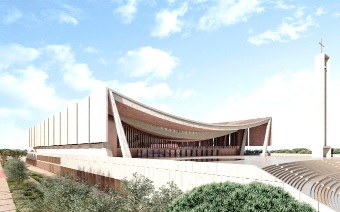
Odyssey of a Cathedral "Lessons from Saint Peter"
ONE venerable figure in the Gospel is Apostle Peter.
Accounts in the Bible tend to describe him as the spokesperson of the Apostles.
Advertisement
Theologians are generally in agreement that he was a key leader of the Apostles; an authoritative figure, who extolled the Messianic credentials of Jesus Christ.
Indeed, Saint Peter presents a whole theological discourse fit for books and I may not be worthy to write such an important discourse.
But the significance of Apostle Peter in the building of the Christian Church is audibly very important, especially at a time many Ghanaians have been riled, whether justifiably or not, by some revelations about our National Cathedral project, which from all indications is in an uncomfortable and loud limbo.
Saint Peter presents a potent and powerful representation; here was a man who was described by Jesus Christ in Matthew 16:18 in this manner; “That thou art Peter, and upon this rock I will build my church; and the gates of hell shall not prevail against it”.
Today, if we are in a quest to build a Cathedral, Saint Peter should present us some very worthy guide.
Some people may be tempted to think of the Bible as some old fabled book; such description is myopic and shallow.
The story of Jesus Christ and the Apostles, and their spiritual and evangelistic work is not a mythological narrative; early historians outside the Bible such as Josephus in the Antiquities of the Jews and Tacitus in Annals wrote about Jesus.
The historicity of Jesus Christ is universally accepted by both historians and theologians.
Historical account
Importantly, this historical account of Jesus and his impact stretches to his disciples and some historians and writers of the early Christian Church note that after his crucifixion, James the Just, his brother, assumed the leadership of the Church in Jerusalem.
But why have I digressed this much? Please, indulge me in this digression some more, as I toss in another apparent digressive vibe: why should James the Just assume the leadership of the Church in Jerusalem when Jesus Christ had prophesied that Peter would be the Rock.
There is disagreement among theologians as to whether this was a usurpation of the leadership of Peter.
Yet, if indeed, there was usurpation then it was, perhaps, in the grand design, as thereafter Peter migrates to Rome; and begins to gather early believers who would later form a Church and would be called Christians.
Some historians agree that Peter’s evangelistic work incurred the displeasure of the Emperor of Rome then, Nero, and the revered Apostle was crucified.
So the early Christians bury him, and some accounts say his burial place became a shrine for some of the Christians.
Between 320 -327 AD(Anno Domini-in the year of the Lord), Constantine the Great, who legalised the practice of Christianity, built a Basilica in the area where his remains were said to have been buried.
The Christian Church eventually developed to become the Catholic Church following the declaration by Emperor Theodosius I of Catholicism as the state religion of the Roman Empire, and out of the Catholic Church emerged all other Christian Churches.
Therefore, Peter, literally and figuratively became the ‘rock’ on which the Church was built.
These are the hard documented historical accounts.
Certainly, the contributions of other key apostles such as Paul and Barnabas cannot be ignored.
But that is not all; the fourth century, Old St Peter’s Basilica gave way to the New St Peter’s Basilica and the new Basilica is still built over what is believed to be the remains of the Apostle Peter.
The new Basilica is an awesome Cathedral.
The construction of the Basilica began in 1506 and was completed in 1615 – a stunning 109-year period. The odyssey of the St Peter’s Basilica teaches us valuable lessons.
We can start with a smaller edifice and get our final structure in all its majestic splendour and glory, perhaps, even 20-years later.
National Cathedral
I am a firm believer in the construction of a National Cathedral.
But we should not build a Cathedral for God under such cloud of suspicion.
Posterity may not judge us kindly. Somehow, we have to resolve the differences and build our Cathedral.
Christian leaders in the country command a lot of respect and deserve every bit of that respect.
If we have to build a Cathedral, they are our best bet to deliver the best results because that is what they do – building Churches for God and helping to nurture and nourish Christians.
Our approach to building our National Cathedral may have to be revised; inspired by Luke 14:28-30, we can start with a primary edifice and gradually add other structures over a period of time.
And, maybe, we don’t really need a National Cathedral situated in a city enclave already brimming with many important buildings.
Maybe, the impact of having the National Cathedral in a place like Amasaman, Dodowa, Aburi, Prampram, Kasoa, Oyibi, Winneba etc. will be much more phenomenal.
Maybe, we should return to the drawing board and re-strategise.
Maybe, just maybe, we will get our Cathedral before the 2024 election, and gather there to sing One Hosanna in worship after we swear in our new president in January 2025.
The writer is a lecturer at the Department of Language and Communication Sciences,
Kwame Nkrumah University of Science and Technology.
E-mail: [email protected]




